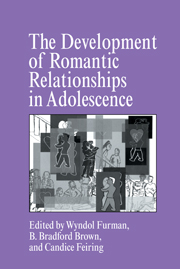Book contents
- Frontmatter
- Contents
- Contributors
- Foreword
- Acknowledgments
- 1 Missing the Love Boat: Why Researchers Have Shied Away from Adolescent Romance
- Part I Processes in Romantic Relationships
- 2 The Emotions of Romantic Relationships: Do They Wreak Havoc on Adolescents?
- 3 The Nature and Functions of Social Exchange in Adolescent Romantic Relationships
- 4 Cognitive Representations of Adolescent Romantic Relationships
- 5 Romantic and Sexual Relationship Development During Adolescence
- Part II Individual Differences in Romantic Relationships
- Part III The Social Context of Romantic Relationships
- Part IV Conclusion
- Author Index
- Subject Index
3 - The Nature and Functions of Social Exchange in Adolescent Romantic Relationships
Published online by Cambridge University Press: 05 October 2014
- Frontmatter
- Contents
- Contributors
- Foreword
- Acknowledgments
- 1 Missing the Love Boat: Why Researchers Have Shied Away from Adolescent Romance
- Part I Processes in Romantic Relationships
- 2 The Emotions of Romantic Relationships: Do They Wreak Havoc on Adolescents?
- 3 The Nature and Functions of Social Exchange in Adolescent Romantic Relationships
- 4 Cognitive Representations of Adolescent Romantic Relationships
- 5 Romantic and Sexual Relationship Development During Adolescence
- Part II Individual Differences in Romantic Relationships
- Part III The Social Context of Romantic Relationships
- Part IV Conclusion
- Author Index
- Subject Index
Summary
For several decades, social psychologists have tilled the fertile fields of interpersonal attraction and close relationships, with impressive results. It is now possible to predict with some certainty the course and future of an adult romantic relationship on the basis of the behaviors and attitudes of the participants (Fletcher & Fincham, 1991; Gottman, 1994). Unfortunately, the study of adolescent romantic relationships has not kept apace with these advances; models generated to describe adult relationships have not been applied systematically to those during adolescence. In this chapter we discuss the nature and functions of adolescent romantic relationships, integrating prevailing theories of social exchange with a developmental perspective on close relationships.
Social exchange theory (Kelley & Thibaut, 1978; Thibaut & Kelley, 1959) provides a popular and compelling framework for understanding adult romantic relationships (Clark & Reis, 1988). Economic principles are extended to interpersonal behavior: Individuals establish and maintain relationships that proffer optimal rewards relative to costs. Widely recognized by social psychologists, exchange theory awaits developmental applications (Graziano, 1984; Laursen, 1996). This oversight is not an indictment of the theory but a manifestation of conceptual neglect in the area of adolescent close peer relationships (Furman, 1993).
- Type
- Chapter
- Information
- The Development of Romantic Relationships in Adolescence , pp. 50 - 74Publisher: Cambridge University PressPrint publication year: 1999
- 53
- Cited by



